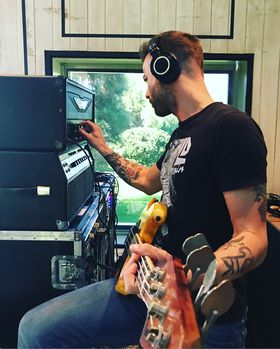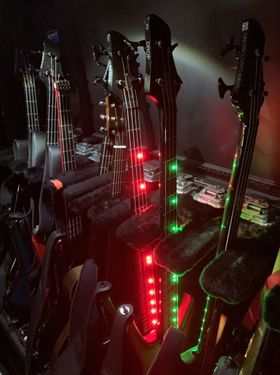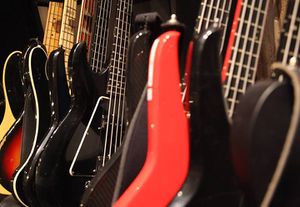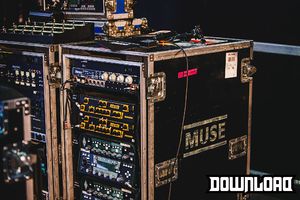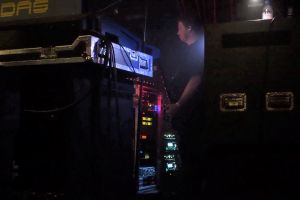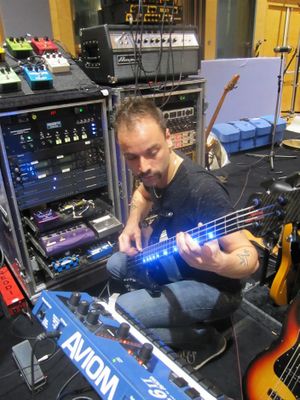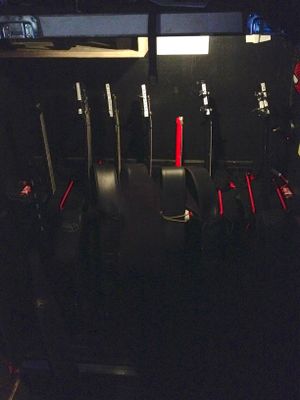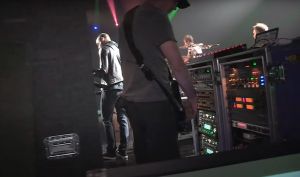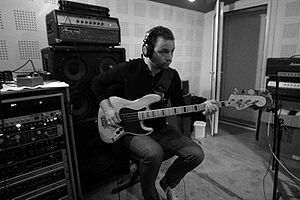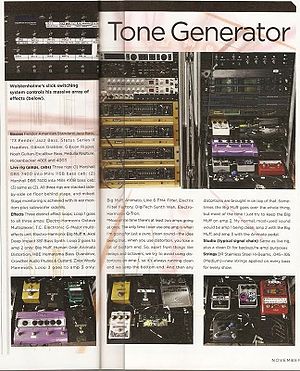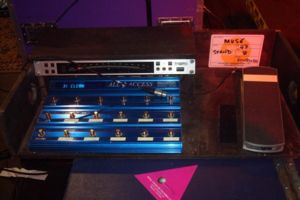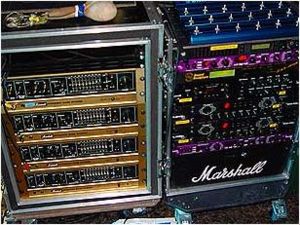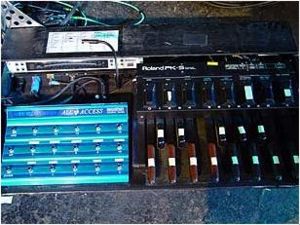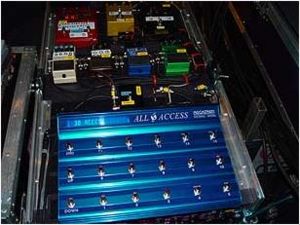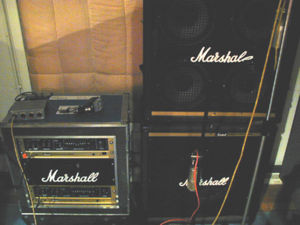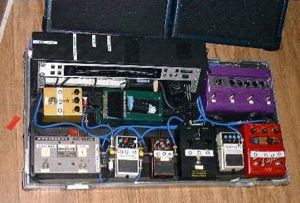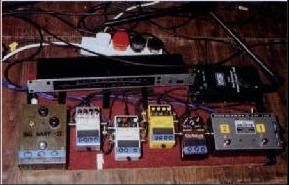Bass
Strings
During Showbiz, OoS tours, Chris equiped his basses with Elites 40-100 stainless steel strings.[1] He then switched to using a couple of unknown brands. After that, he moved to DR Strings at around 2006 and has been using them ever since. According to Wolstenholme, the DR Strings retain the brightness even after being played for one gig, which is why he chose them.[2] He's currently using DR MR-45 Hi-Beam roundcore 45-105 stainless steel strings. He has also been seen with the DR Neon color coated strings with the colours of the British flag during the 2012 London Olympics Closing Ceremony performance, allthough he has not actually played them live.
Straps
Wolstenholme mainly uses leather straps from Status Graphite. Before that (BH&R and The Resistance tours) he has been using the ones from Manson Guitar Works - the same as Bellamy uses. Previously, he used a few unknown-brand leather straps.
Will Of The People
Despite not as much footage from the recording of the upcoming album released yet, a few of Chris's basses and other gear were spotted in the L.A. studio at which they were recording the album here and there. From a video posted by Aleks Von Korff, touring the studio, a previously unseen pedal, the JHS 4 Wheeler Bass Fuzz, can be seen sitting next to a ZVex Woolly Mammoth on the control desk. It is unknown though, whether or not the pedal is actually going to be used in the album, or if it was just used for demo track purposes. The butterscotch 1973 Jazz Bass can also be seen sitting in the studio.
On the short clips of Matt and Dom talking about the Origin of Symmetry RemiXX, an Ampeg SVT-VR can be seen in the studio's live room, sitting on top of an Ampeg 4x10 cabinet, aswell as a Markbass SD 1200 head next to them.[3]
In another post by Aleks Von Korff, two Dunlop Bass Wah pedals can be seen in the studio, used for Won't Stand Down. Additionally, either a pedal or a plugin version of the Geiger Counter distortion/bit crusher was used in combination with the wah, as noted on the Pro Tools session seen in the video. A few weeks later, Muse posted a TikTok video, with Chris playing WSD on his signature Status black 5-string bass, meaning it was likely used for the song, due to the drop-B tuning.[4]
For live shows, he returned back to having an expression pedal for a wah on-stage, used for Won't Stand Down. Chris (and Matt) also had a smaller version of RJM Music Mastermind GT/22's on stage (the Mastermind GT/10), for the secret Cavern Club gig in April of 2022, due to the size of the stage. As far as basses go, Chris added two new basses to his setup; The Status Stealth 5-string and the Status S2-Classic 5-string, the latter one used as the Status Stealth replacement.
A large change in Chris's set up is that he has now ditched all miked cabinets, according to Muse's monitor tech, Liam Tucker. Instead, he is using Fractal Audio units for cab simulation.[5]
Studio
Basses
- Status Chris Wolstenholme Signature Bass
- Status Chris Wolstenholme Signature Bass 5-string
- Fender '73 Jazz Bass
Amps
Pedals (Off-Rack)
- Dunlop Crybaby Bass Wah
- WMD Devices Geiger Counter
- JHS 4 Wheeler Bass Fuzz<
Live
Basses
- Status The KingBass Mk-II (Walnut)
- Status The KingBass Mk-II (Graphite/Green-LED)
- Status Chris Wolstenholme Signature Bass (Aqua Blue/White-LED)
- Status Chris Wolstenholme Signature Bass (Chrome/TriColor-LED)
- Status Chris Wolstenholme Signature Bass (Graphite/Blue-LED)
- Status Chris Wolstenholme Signature Bass (Graphite/Red-LED)
- Status Chris Wolstenholme Signature Bass (Indigo Blue/White-LED Strips)
- Status Chris Wolstenholme Signature Bass 5-string (Stealth/White-LED)
- Status Chris Wolstenholme Signature Bass 5-string (Aqua Blue/Blue-LED)
- Status S2-Classic 5-string (Stealth)
- Status Stealth 5-string (Graphite)
- Status Kitara Doubleneck Bass Mk2
- Fender Geddy Lee Signature Jazz Bass (Satin Black/Maple fretboard)
- Fender '77 Jazz Bass (Sunburst/Maple fretboard)
On-Stage Pedalboard
- RJM Mastermind GT/22 Foot Controller (on-stage)
- RJM Mastermind GT/10 (on-stage - one show only)
- Korg Pitchblack Pro Tuner
- Expression Pedal
NA Summer Amphitheatre Tour 2017 & Simulation Theory
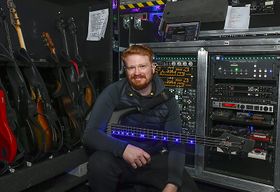
For the 2017 North American Summer Amphitheatre Tour, Chris mostly kept the same setup as for the Drones tour. He only added two new basses: The new graphite-covered green-LED Status The KingBass Mk-II and the new version of the Status Kitara Doubleneck Bass for Madness. For the Simulation Theory tour, he also kept the setup fairly similar, but he used three new basses (including the Keyboard Bass) and switched from the Skrydstrup MR10 system to an RJM Effect Gizmo system. A couple of new stompboxes were also added, and the bulky Kemper profilers were replaced with slightly smaller rack-mount verisons.
In the studio, while making Simulation Theory, Chris has been seen using '73 Jazz Bass, a '77 Jazz Bass and his Status signature basses. The Ampeg SVT-VR was used yet again in the studio setup, but an Ashdown BTA-400 head was seen for the first time being used by Wolstenholme. According to Chris, he wanted to use more of the old Fender Jazz Bass sound due to the album having an 80s feel, as opposed to mainly using Status bass guitars, which have a more modern sound. Wolstenholme also mentioned, while speaking to John Kennedy on Radio X, that another difference, compared to recording previous albums was, that they've mostly recorded Simulation Theroy with clean bass going straight into the console, giving them the flexibility to manipulate the sound later, in the DAW.
Studio
Basses
- Status Chris Wolstenholme Signature Bass (Graphite/Blue-LED)
- Fender '77 Jazz Bass
- Fender '73 Jazz Bass
Amps
Rack 1
- ETA Systems EPD11 LVIEC-CE Power Distribution Unit
- Empirical Labs Distressor
- Custom Connector Panel
- 2x Markbass SD 1200
- 2x Kemper Profiling Amplifier
- Skrydstrup Input Selector
Rack 2
- ETA Systems EPD11 LVIEC-CE Power Distribution Unit
- Skrydstrup Custom Routing Interface
- Shure UA845 Antenna Distribution Unit
- 2x Shure UR4D Dual Wireless Reciever
- 2x Skrydstrup MR10 Loop System
- TC Electronic G-Major 2
- Unknown
Amps
- Markbass SD 1200
- Ampeg SVT-VR
- Ashdown BTA400
Live
Basses
- Status The KingBass Mk-II (Amphitheatre Tour only)
- Status Chris Wolstenholme Signature Bass (Graphite/Blue-LED)
- Status Chris Wolstenholme Signature Bass (Graphite/Red-LED)
- Status Chris Wolstenholme Signature Bass (Aqua Blue/White-LED)
- Status Chris Wolstenholme Signature Bass (Chrome/TriColor-LED)
- Status Chris Wolstenholme Signature Bass (Indigo Blue/White-LED Strips)
- Status Chris Wolstenholme Signature Bass 5-string (Graphite/Green-LED)
- Status Chris Wolstenholme Signature Bass 5-string (Aqua Blue/White-LED) (replaced with Stealth)
- Status Chris Wolstenholme Signature Bass 5-string (Stealth) (Blue/White-Led replacement)
- Status "The Uprising Bass"
- Status Kitara Doubleneck Bass Mk2
- Status Keyboard Bass
- Fender '77 Jazz Bass (Sunburst/Maple fretboard) (replaced with Geddy Lee Signature Bass)
- Fender Geddy Lee Signature Jazz Bass (Satin Black/Maple fretboard) ('77 Jazz Bass replacement)
- Status S2-Classic (back-up)
Amps
Cabs
Rack 1
- Power Conditioner Unit (Unknown)
- Empirical Labs Distressor
- 2x Markbass SD 1200
- 3x Kemper Profiling Amplifier
- Skrydstrup Input Selector
Rack 2
- Power Conditioner Unit (Unknown)
- Skrydstrup Custom Routing Interface
- 2x Shure AD4D Dual Wireless Reciever
- 2x RJM Effect Gizmo
- TC Electronic G-Major 2
FX Tray 1
- Electro-Harmonix Black Russian Big Muff Pi
- Boss OC-2
- MXR M109 Six Band EQ
- Crowther Audio Prunes and Custard
- Unknown
FX Tray 2
FX Tray 3
Tuner
- Peterson AutoStrobe 490 Tuner
- TC Electronic Polytune Mini
Control
- RJM Mastermind GT/22 Foot Controller (off-stage)
On-Stage Pedalboard
- RJM Mastermind GT/22 Foot Controller (on-stage)
- Korg Pitchblack Pro Tuner
Other
- Panda Audio midiBeam Wireless MIDI Transmitter
- Apple Mac Book Pro (running MainStage)
Drones
During the recording of Drones, Chris mainly used Status bass guitars again, allthough a Rickenbacker and the Gibsons were also spotted in the studio. Most of the time, he ran them through his Ampeg SVT-VR head for the clean channel and two Marshall DBS 7400s for distorted channels. It's also possible he used Markbass SD 1200 heads for clean occasionally. Later, for the cover of New Kind of Kick, he likely used a Gretsch Thunder Jet, seen in the video, in the studio. In terms of effects, he included a few new stompboxes. In the studio, he used a ZVex Basstortion, a Mt'Lab Fat Humster and a Pigtronix Disnortion. The latter one, he also uses live for Psycho's bridge parts.
As for the live setup, Chris kept his collection of rack gear and basses roughly the same as for The 2nd Law tour, with the 5-string Jazz Bass making a return for a couple of Assassin performances. The Chris Wolstenholme Status Graphite 5-String bass also made appearances for Assassin. The rack was almost exactly the same as with the T2L tours with two Kempers and two Markbass SD 1200 heads, plus the afforementioned Disnortion pedal. The only change that occured during the tour was the switch from Liquid Foot Pro MIDI foot controllers to more customisable RJM Music's Mastermind GT/22 MIDI controllers.
Studio
Basses
- Status S2-Classic (Graphite)
- Status S2-Classic (Graphite/Blue-LED)
- Status "The Uprising Bass"
- Status Super-Vintage GP
- Gibson Grabber
- Gibson Ripper
- Rickenbacker 4003
- Fender '77 Jazz Bass (Sunburst/Maple fretboard)
- Gretsch G6128B Thunder Jet
Amps
Cabs
Rack 1
- ETA Systems EPD11 LVIEC-CE Power Distribution Unit
- Skrydstrup Custom Routing Interface
- Shure UA845 Antenna Distribution Unit
- 2x Shure UR4D Dual Wireless Reciever
- 2x Skrydstrup MR10 Loop System
- TC Electronic G-Major 2
- Electrix Filter Factory
- 2x Paul Lenders Muse AC-Tool Power Supply Unit
Rack 2
- ETA Systems EPD11 LVIEC-CE Power Distribution Unit
- Empirical Labs Distressor
- Custom Connector Panel
- Markbass SD 1200
- 2x Kemper Profiling Amplifier
FX Tray 1
- Electro-Harmonix Black Russian Big Muff Pi (perhaps)
- ZVex Basstortion (perhaps)
- ZVex Woolly Mammoth (perhaps)
- Unknown
FX Tray 2
- Electro-Harmonix Black Russian Big Muff Pi (perhaps)
- Boss OC-2 (perhaps)
- Crowther Audio Prunes & Custard
- Pigtronix Disnortion (perhaps)
- Unknown
FX Tray 3
- Electro-Harmonix POG (perhaps)
- Unknown
Control
Live
Basses
- Status Chris Wolstenholme Signature Bass (Graphite/Blue-LED)
- Status Chris Wolstenholme Signature Bass (Graphite/Red-LED)
- Status Chris Wolstenholme Signature Bass (Aqua Blue/White-LED)
- Status Chris Wolstenholme Signature Bass (Chrome/TriColor-LED)
- Status Chris Wolstenholme Signature Bass (Stealth/White-LED)
- Status Chris Wolstenholme Signature Bass 5-string (Aqua Blue/Blue-LED)
- Status "The Uprising Bass"
- Status The KingBass Mk-II (Walnut)
- Status Kitara Doubleneck Bass Mk1
- Fender '77 Jazz Bass (Sunburst/Maple fretboard)
- Fender American Deluxe Jazz Bass 5-string (Black/Maple fretboard)
Amps
Cabs
Rack 1
- ETA Systems EPD11 LVIEC-CE
- Skrydstrup Custom Routing Interface
- Shure UA845 Antenna Distribution Unit
- 2x Shure UR4D Dual Wireless Reciever
- 2x Skrydstrup MR10 Loop System
- TC Electronic G-Major 2
- Electrix Filter Factory
- 2x Paul Lenders Muse AC-Tool Power Supply Unit
Rack 2
- ETA Systems EPD11 LVIEC-CE
- Empirical Labs Distressor
- Custom Connector Panel
- 2x Markbass SD 1200
- 2x Kemper Profiling Amplifier
FX Tray 1
- MXR M109 Six Band EQ
- Electro-Harmonix Black Russian Big Muff Pi
- Crowther Audio Prunes & Custard
- Unknown
FX Tray 2
- Digitech Bass Synth Wah
- Unknown
FX Tray 3
Tuner
- Peterson AutoStrobe 490 Tuner
Control
- Liquid Foot Pro Foot Controller (off-stage) (early)
- RJM Mastermind GT/22 Foot Controller (off-stage)
On-Stage Pedalboard
- Liquid Foot Pro Foot Controller (on-stage) (early)
- RJM Mastermind GT/22 Foot Controller (on-stage)
- Korg Pitchblack Pro Tuner
The 2nd Law
For The 2nd Law, Chris kept the same studio setup as he used on The Resistance tour, but included more pedals (seen in the picture, above the racks) and two Markbass SD 1200 heads. Live, he replaced the Marshall DBS 7400 amps completely with the afforementioned SD 1200s (clean channels) and two Kemper Profiling Amplifier heads (for overdrive channels), with the DBS 7400 amps all profiled.
With Status bringing out his signature model, for live gigs, he ditched most of the Fender Jazz Basses, the Rickenbacker and the Gibson Ripper, and started playing Status basses almost exclusively.
Studio
Basses
- Status S2-Classic (Graphite)
- Status S2-Classic (Graphite-LED)
- Status Chris Wolstenholme Signature Bass (Graphite/Blue-LED)
- Fender '77 Jazz Bass (Sunburst/Maple fretboard)
- Status Super-Vintage GP
- Dean Stylist
- Gibson Grabber
- Status S2-Classic (Walnut)
Amps
Cabs
Rack 1
- ETA Systems EPD11 LVIEC-CE Power Distribution Unit
- Skrydstrup Custom Routing Interface
- Shure UA845 Antenna Distribution Unit
- 2x Shure UR4D Dual Wireless Reciever
- 3x Skrydstrup MR10 Loop System
- Electrix Filter Factory
- 2x Paul Lenders Muse AC-Tool Power Supply Unit
Rack 2
- ETA Systems EPD11 LVIEC-CE Power Distribution Unit
- TC Electronic G-Major 2
- Line 6 Bass POD XT Pro
- 2x Tech 21 SansAmp PSA-1.1
- Custom Connector Panel
- 4x Marshall DBS 7400
FX Tray 1 (Rack-Top)
- Way Huge Aqua-Puss
- Way Huge Green Rhino
- Way Huge Fat Sandwich
- Way Huge Swollen Pickle
- Way Huge Angry Troll
- Crowther Audio Prunes & Custard
FX Tray 2
FX Tray 3
- Line 6 FM4 Filter Modeler
- Electro-Harmonix Octave Multiplexer
- Electro-Harmonix Black Russian Big Muff Pi (perhaps)
FX Tray 4
- HBE Hematoma Bass Overdrive/Pre-Amp
- ZVex Mastotron
- Electro-Harmonix Black Russian Big Muff Pi (perhaps)
- Boss OC-2 (perhaps)
Control
Other
- A Designs REDDI Tube Direct Box
Live
Basses
- Fender '73 Jazz Bass (Butterscotch/Rosewood fretboard)
- Fender '77 Jazz Bass (Sunburst/Maple fretboard)
- Status Chris Wolstenholme Signature Bass (Graphite/Blue-LED)
- Status Chris Wolstenholme Signature Bass (Graphite/Red-LED)
- Status Chris Wolstenholme Signature Bass (Aqua Blue/White-LED)
- Status Chris Wolstenholme Signature Bass 5-string (Graphite/Green-LED)
- Status Original Series II (Mahogany)
- Status "The Uprising Bass"
- Status S2-Classic (Walnut)
- Status The KingBass Mk-II (Walnut)
- Status Kitara Doubleneck Bass Mk1
Amps
Cabs
Rack 1
- ETA Systems EPD11 LVIEC-CE Power Distribution Unit
- Skrydstrup Custom Routing Interface
- Shure UA845 Antenna Distribution Unit
- 2x Shure UR4D Dual Wireless Reciever
- 2x Skrydstrup MR10 Loop System
- TC Electronic G-Major 2
- Electrix Filter Factory
- 2x Paul Lenders Muse AC-Tool Power Supply Unit
Rack 2
- ETA Systems EPD11 LVIEC-CE Power Distribution Unit
- Empirical Labs Distressor
- Custom Connector Panel
- Tech 21 SansAmp PSA-1.1
- 2x Markbass SD 1200
- 2x Kemper Profiling Amplifier
FX Tray 1
FX Tray 2
- Line 6 FM4 Filter Modeler
- Human Gear Animato Distortion (perhaps)
- Unknown
FX Tray 3
- Unknown
Tuner
- Boss TU-2 Chromatic Tuner
Control
- Liquid Foot Pro Foot Controller (off-stage)
On-Stage Pedalboard
Other
- Apple Mac Book Pro (running MainStage)
The Resistance
For The Resistance era, Chris expanded his setup even more, especially in terms of the rack gear. This was also the first tour that Chris started using Status basses with the first one being the Status Original Series II. He changed the switching systems, swapping out both the on-stage and off-stage controllers from Rocktron's All Access to FAMC's Liquid Foot Pro, and ditching the Sound Sculpture Switchblade GL, instead opting for two Skrydstrup MR10 looper units.
Both the studio and live setups were the same, excluding the bass and amp selection, with an Ampeg SVT-VR head spotted in the studio.
Studio
Basses
- Fender American Deluxe Jazz Bass (Candy Tangerine/Rosewood fretboard)
- Fender American Deluxe Jazz Bass (Candy Tangerine/Maple fretboard)
- Fender American Deluxe Jazz Bass (Black/Maple fretboard)
- Fender American Deluxe Jazz Bass (Pearlescent White/Maple fretboard)
- Fender American Vintage '75 Jazz Bass (Natural/Maple fretboard)
- Fender '77 Jazz Bass (Sunburst/Maple fretboard)
- Status Original Series II (Walnut)
- Gibson Ripper
- Gibson Grabber
- Pedulla Rapture RB4-4 (Candy Blue)
Amps
Cabs
Live
Basses
- Fender American Standard Jazz Bass (Blizzard Pearl/Rosewood fretboard)
- Fender American Deluxe Jazz Bass (Candy Tangerine/Rosewood fretboard)
- Fender American Deluxe Jazz Bass (Candy Tangerine/Maple fretboard)
- Fender American Deluxe Jazz Bass (Black/Maple fretboard)
- Fender American Deluxe Jazz Bass (Pearlescent White/Maple fretboard)
- Fender American Deluxe Jazz Bass 5-string (Black/Maple fretboard)
- Fender American Vintage '75 Jazz Bass (Natural/Maple fretboard)
- Fender American Deluxe Jazz Bass (Chrome/Maple fretboard)
- Noah Guitars Excalibur Bass
- Rickenbacker 4003
- Status Original Series II (Mahogany)
- Status The KingBass MK II (Walnut)
- Gibson Grabber
- Status S2-Classic (Walnut)
- Status S2-Classic (Graphite)
- Status S2-Classic (Graphite-LED)
- Status Super-Vintage GP
Amps
Cabs
Rack 1
- Electrix Filter Factory
- ETA Systems EPD11 LVIEC-CE Power Distribution Unit
- TC Electronic G-Major 2
- Line 6 Bass POD XT Pro
- 2x Tech 21 SansAmp PSA-1.1
- Custom Connector Panel
- 4x Marshall DBS 7400
Rack 2
- ETA Systems EPD11 LVIEC-CE Power Distribution Unit
- Skrydstrup Custom Routing Interface
- Shure UA845 Antenna Distribution Unit
- 2x Shure UR4D Dual Wireless Reciever
- 2x Skrydstrup MR10 Loop System
- Sound Sculpture Switchblade GL
- 2x Paul Lenders Muse AC-Tool Power Supply Unit
FX Tray 1
- Human Gear Animato Distortion
- Electro-Harmonix Black Russian Big Muff Pi
- Electro-Harmonix Vintage Octave Multiplexer
- Crowther Audio Prunes & Custard
- ZVex Woolly Mammoth
FX Tray 2
- Human Gear Animato Distortion
- 2x Electro-Harmonix Black Russian Big Muff Pi
- Digitech Bass Synth Wah
- Line 6 FM4 Filter Modeler
FX Tray 3
- Boss OC-2 Octave
- Electro-Harmonix Micro Q-Tron
- Akai Deep Impact SB1 Bass Synthesiser Pedal
- HBE Hematoma Bass Overdrive/Pre-Amp
- Gap with 2 disconnected patch cables, possibly for the Boss DD-3
Tuner
- Boss TU-2 Chromatic Tuner
Control
- Liquid-Foot Pro MIDI Controller (off-stage)
On-Stage Pedalboard
- Liquid-Foot Pro MIDI Controller (on-stage)
- Korg DTR2000 Tuner
- Ernie Ball EX-S Expression Pedal (controls the Filter Factory)
Black Holes and Revelations
Not much is known about Chris' gear during the BH&R era as there were little to no pictures of his gear taken during the period, however it is known that Chris started using Fender Jazz Basses a lot more frequently. He also ditched the on-stage amps/cabs halfway through the tour, and started miking them backstage. Instead, he only opted for an on-stage subwoofer, so he could still feel the sub low end, and he also took away the MIDI foot pedal controller. Based on the pictures, Chris (like Matt) stayed with an All Access controller and a Sound Sculpture Switchblade GL, before upgrading.
Based on some interviews, Chris added four more Marshall DBS 7400 heads to his setup, having eight in total.[6]
Basses
- Fender American Standard Jazz Bass (Blizzard Pearl/Rosewood fretboard)
- Fender American Deluxe Jazz Bass (Candy Tangerine/Rosewood fretboard)
- Fender American Deluxe Jazz Bass (Candy Tangerine/Maple fretboard)
- Fender American Deluxe Jazz Bass (Black/Maple fretboard)
- Fender American Deluxe Jazz Bass (Pearlescent White/Maple fretboard)
- Fender American Deluxe Jazz Bass 5-string (Black/Maple fretboard)
- Fender American Vintage '75 Jazz Bass (Natural/Maple fretboard)
- Rickenbacker 4003
- Pedulla Rapture RB4-4 (Candy Blue) (only for Micro Cuts live)
- Custom Manson 8-String Bass (never used)
Amps
Cabs
- Marshall 7215 2x15 Cabinet (on-stage monitoring)
Control
On-Stage Pedalboard
- Korg DTR-1 Rack Tuner
- Rocktron All Access Foot Controller (on-stage)
- Ernie Ball EX-S Expression Pedal
Absolution
With the evolving complexity of Muse's sound, for the Absolution tour, Chris moved all of his pedals, other effects and amps into the rack. Both him and Matt got into MIDI switching systems, with their techs switching the effects on or off; A system, which they still use. Specifically, they moved to Rocktron's All Access switcher, controlling the Sound Sculpture Switchblade GL.
Wolstenholme also got two more of the Marshall DBS 7400 bass amplifiers into the rig, meaning he could now run two amplifiers for effects (one running an Animato pedal and another one running a Big Muff pedal) and another amplifier running clean, with the fourth amplifier serving a back-up amp. In terms of effects, he added in a Line 6 Bass POD XT Pro and two Line 6 Bass POD Pro multi-effects units, two Line 6 Filter Pro rack units, aswel as two pedals; a DigiTech Bass Synth Wah and a Boss PS-3 Pitch Shift.
Basses
- Pedulla Rapture RB4-4 (Candy Blue)
- Pedulla Rapture RB4-4 (Flat Black)
- Pedulla Rapture RB4-4 (Candy Red)
- Zon Sonus Custom 4
- Fender American Deluxe Jazz Bass (Candy Tangerine/Rosewood fretboard)
- Fender American Standard Jazz Bass (Blizzard Pearl/Rosewood fretboard) (only for Sing for Absolution live)
- Custom Manson 8-String Bass (never used)
Amps/Rack (left)
Rack (right)
- Shure UHF receiver
- 2x Line 6 Filter Pro
- Sound Sculpture Switchblade GL Switcher/Router
- Line 6 Bass POD XT Pro
- 2x Line 6 Bass POD Pro
FX Tray
- Akai Deep Impact SB1 Bass Synthesiser Pedal
- Human Gear Animato Distortion
- Electro-Harmonix Black Russian Big Muff Pi
- Boss DD-3 Digital Delay
- Boss OC-2 Octaver
- Boss PS-3 Pitch Shift
- Digitech Bass Synth Wah
Control
On-Stage Pedalboard
- Korg DTR-1 Rack Tuner
- Rocktron All Access Foot Controller (on-stage)
- Roland PK-5 Dynamic Foot Pedal
Other
Origin of Symmetry
During the OoS tour, Chris got his Marshall DBS 7400 Dynamic Bass System amplifiers and cabinets. He also got a Black Russian Big Muff Pi and a Human Gear Animato pedal, aswell as an Akai Deep Impact SB1 Bass Synth pedal. The combination of these two pedals remain part of his staple sound to this day.
Basses
- Pedulla Rapture RB4-4 (Tobacco Sunburst)
- Pedulla Rapture RBJ2-4 (Candy Blue)
- Pedulla Rapture RB4-4 (Candy Blue)
- Pedulla Rapture RB4-4 (Flat Black)
- Pedulla Rapture RB4-4 (Candy Red)
- Warwick Streamer Pro M (only used in the New Born music video)
Rack
- Marshall B150 Bass Combo (Not in the picture; Sat on top of rack)
- 2x Marshall DBS 7400 Head
- Rack Drawer w/ Marshall Sticker
Cabs
Pedalboard
- Human Gear Animato Distortion
- Boss LS-2 Line Selector
- Boss OC-2 Octaver
- Electro-Harmonix Black Russian Big Muff Pi
- Boss DD-3 Digital Delay
- Akai Deep Impact SB1 Bass Synthesiser Pedal
- Line 6 FM4 Filter Modeler
- Pete Cornish Line Selector
- Korg DTR-1 Rack Tuner
- Power Supply Unit
Showbiz
Allthough amplifiers and basses remained the same, Chris used two effects setups during the Showbiz era; On some early gigs, he only used the Boss OS-2 Overdrive/Distortion, plugged into the Pete Cornish Line Selector and running into the amps.
Basses
- Pedulla Rapture RB4-4 (Tobacco Sunburst)
- SGC Nanyo Bass Collection SB330
- SGC Nanyo Bass Collection SB300
- Clifton Electric Upright Bass
Amps
Pedalboard
- Electro-Harmonix Green Russian Big Muff Pi
- Boss DD-3 Digital Delay
- Boss LS-2 Line Selector
- Boss OS-2 Overdrive/Distortion
- Boss OC-2 Octave
- Pete Cornish Line Selector
- Korg DTR-1 Rack Tuner
- Power Supply Unit
References
- ↑ 2002 Bass Guitar Magazine Interview
- ↑ https://www.facebook.com/watch/?v=627896448019156
- ↑ https://youtu.be/VABzIa6fjiI?t=25
- ↑ https://www.tiktok.com/@muse/video/7060196209272704262
- ↑ https://mydigitalpublication.com/publication/?m=19395&i=792822&p=28&ver=html5
- ↑ https://www.mixonline.com/live-sound/all-access-muse-367983
